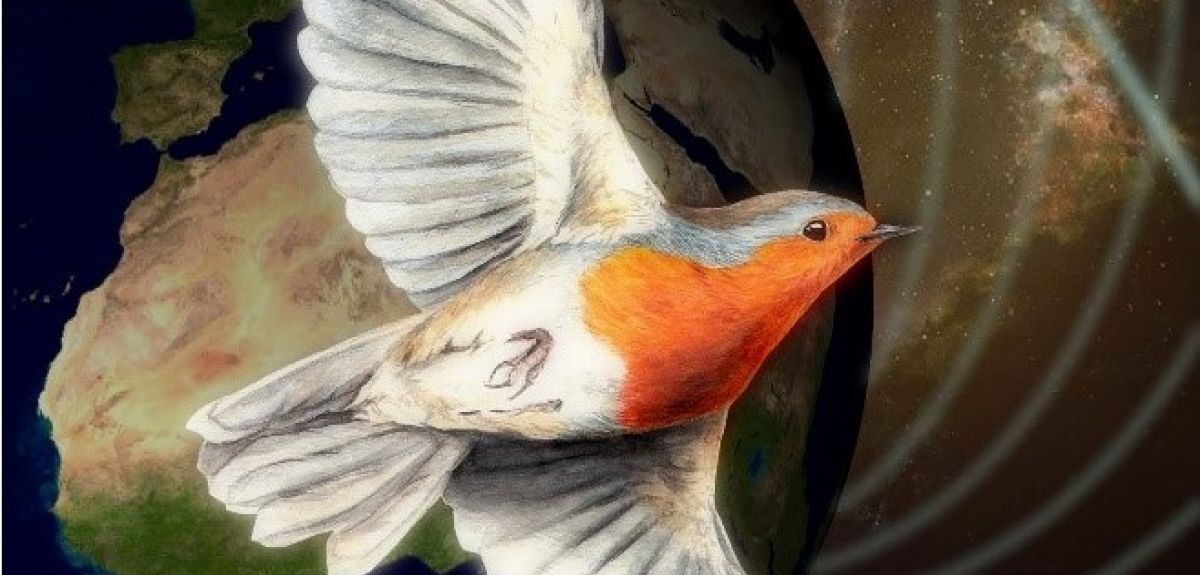
Credit: Corinna Langebrake, Ilia Solov’yov
How birds sense the magnetic field of the Earth to help them navigate
Humans perceive the world around them with five senses – vision, hearing, taste, smell and touch. Many other animals are also able to sense the Earth’s magnetic field. For some time, a collaboration of biologists, chemists and physicists from the Universities of Oxford (UK) and Oldenburg (Germany) have been accumulating evidence that the magnetic sense in night migratory birds, such as the European robin, is based on a specific light‐sensitive protein in the eye. In the current edition of the journal Nature, this group demonstrates that the protein cryptochrome 4, found in birds’ retinas, is sensitive to magnetic fields and could well be the long‐sought magnetic sensor.
A collaboration of biologists, chemists and physicists have been accumulating evidence that the magnetic sense in night migratory birds, such as the European robin, is based on a specific light‐sensitive protein in the eye.
Henrik Mouritsen’s research group in Oldenburg succeeded in extracting the genetic code for cryptochrome 4 in night‐migratory European robins and then produced the protein in large quantities using bacterial cell cultures. Christiane Timmel’s and Stuart Mackenzie’s groups in the Oxford Chemistry Department then applied a wide range of magnetic resonance and novel optical techniques to study this protein and demonstrated its pronounced sensitivity to magnetic fields. The measurements required the development of new instruments by several generations of talented postdoctoral researchers and graduate students.
The team also shed light on the mechanism by which this sensitivity arises – based on electron transfer reactions triggered by absorption of blue light. Proteins like cryptochrome consist of chains of amino acids: robin cryptochrome 4 has 527 of them. Oxford’s Peter Hore and Oldenburg physicist Ilia Solov'yov performed quantum mechanical calculations supporting the idea that four of the 527 – known as tryptophans – are essential for the magnetic properties of the molecule.
According to their calculations electrons hop from one tryptophan to the next generating so‐called radical pairs which are magnetically sensitive.
According to their calculations electrons hop from one tryptophan to the next generating so‐called radical pairs which are magnetically sensitive. To test this experimentally, the team from Oldenburg produced slightly modified versions of the robin cryptochrome, in which each of the tryptophans in turn was replaced by a different amino acid to block the movement of electrons. Using the modified proteins, the Oxford groups were able to elucidate the role of different radical pairs in the observed magnetic field effects.
"We think these results are very important because they show, for the first time, that a molecule from the visual apparatus of a migratory bird is sensitive to magnetic fields" says Mouritsen. But this is not, the team emphasises, definitive proof that cryptochrome 4 is the magnetic sensor. In all experiments, the researchers examined isolated proteins in the laboratory and applied magnetic fields stronger than the Earth's magnetic field. "It therefore still needs to be shown that this is happening in birds’ eyes", Mouritsen stresses. Such studies are not yet technically possible.
However, the authors think the proteins involved could be significantly more sensitive in their native environment. In cells in the retina, the proteins are probably fixed and aligned, increasing their sensitivity to the direction of the magnetic field. Moreover, they are also likely to be associated with other proteins that could amplify the sensory signals. The search is on for these, as yet unknown, interaction partners.
These results show, for the first time, that a molecule from the visual apparatus of a migratory bird is sensitive to magnetic field.
Hore says: “If we can prove that cryptochrome 4 is the magnetic sensor we will have demonstrated a fundamentally quantum mechanism that makes animals sensitive to environmental stimuli a million times weaker than previously thought possible”.
The magnetic field effect work has been supported by external funding agencies such as DARPA; the US Air Force Office of Scientific Research; the EMF Biological Research Trust; the Office of Naval Research Global; the U.S. Army Research Office, an element of the DEVCOM Army Research Laboratory; the German Science Foundation; the SCG Innovation fund and the European Research Council. It is currently supported by the ERC Synergy Grant ‘QuantumBirds’.
Christiane Timmel is Professor of Chemistry in Oxford and Director of the Oxford Centre for Advanced Electron Paramagnetic Resonance (CAESR).
Peter Hore and Stuart Mackenzie are Professors of Chemistry in Oxford.
Full paper: Magnetic sensitivity of cryptochrome 4 from a migratory songbird, Nature (2021). DOI: 10.1038/s41586-021-03618-9, www.nature.com/articles/s41586-021-03618-9